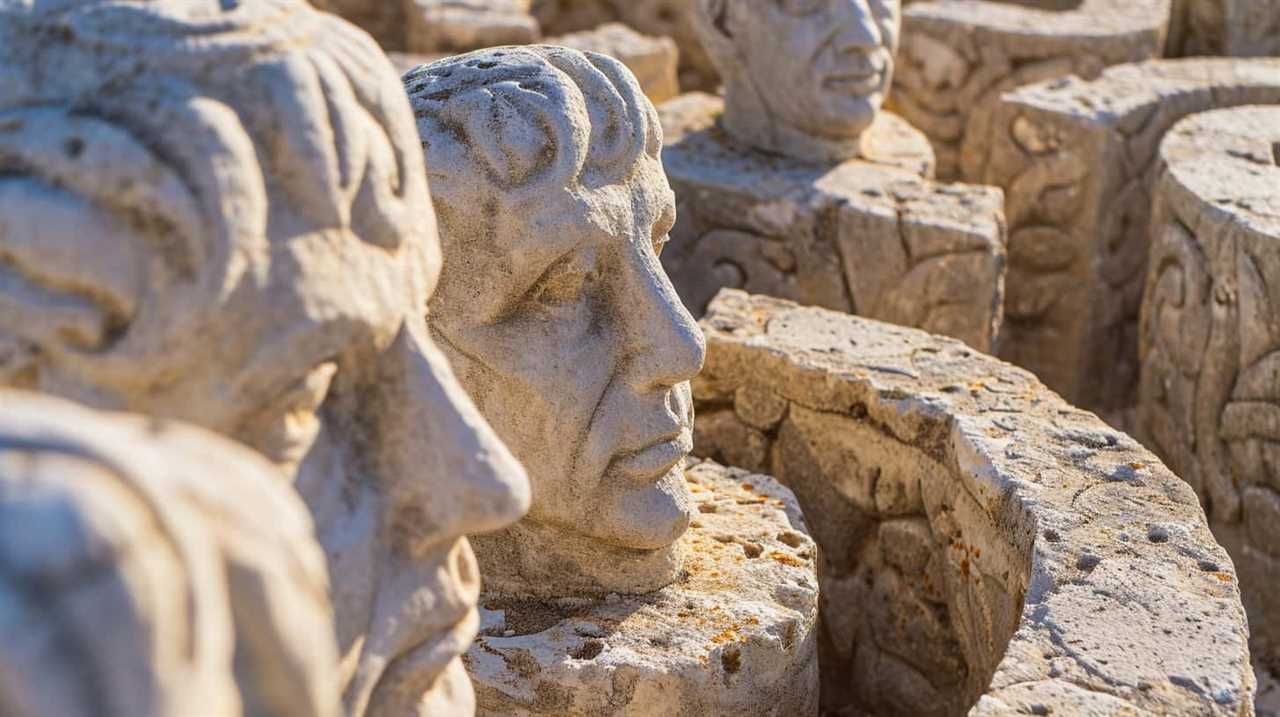Famous Personalities
Ben Graham Quotations: Timeless Investment Wisdom

Benjamin Graham, the father of security analysis and value investing, is revered as one of the greatest investors of all time. His insights and wisdom are immortalized in his books, Security Analysis (1934) and The Intelligent Investor (1949), which are considered essential reading for investors. In this article, we will explore Graham’s timeless investment principles and the profound impact they have on shaping successful investment strategies.
Key Takeaways
- Benjamin Graham’s investment philosophy is rooted in value investing.
- Always invest with a margin of safety by buying stocks at a discount to their intrinsic value.
- Volatility in the stock market can be embraced as an opportunity for profit.
- Strategies like dollar-cost averaging and maintaining a balanced portfolio can mitigate the effects of market volatility.
- Understanding your investment personality and choosing the right approach is crucial for success.
Benjamin Graham’s Value Investing Philosophy
Benjamin Graham, a legendary figure in the world of investing, is renowned for his timeless wisdom and profound insights into value investing. At the core of Graham’s investment philosophy lies the concept of buying stocks with a margin of safety, a principle that remains as relevant today as it was during his time. Value investing, as championed by Graham, focuses on identifying stocks that are undervalued in the market, presenting an opportunity for investors to potentially benefit from their intrinsic value.
Graham believed in conducting thorough analysis and understanding the true worth of a company before making investment decisions. By purchasing stocks at a significant discount to their intrinsic value, investors can protect themselves from potential downturns in the market. Graham’s value investing philosophy emphasizes the importance of making informed decisions based on careful evaluation rather than succumbing to market speculation or irrational behavior.
We should have a one-line investment thesis that explains what the company does and why it offers an attractive investment opportunity.
Furthermore, Graham’s remarkable insights and wisdom are encapsulated in his memorable quotes and sayings. These quotes serve as guiding principles for investors and highlight the essence of value investing and smart decision-making in the stock market. Let’s explore some of his best investment quotes that continue to resonate with investors:
- “The stock market is filled with individuals who know the price of everything, but the value of nothing.”
- “In the short run, the market is a voting machine, but in the long run, it is a weighing machine.”
- “Buy when everyone else is selling and hold when everyone else is buying. This is not merely a catchy slogan; it is the essence of successful investing.”
These quotes by Ben Graham underscore the importance of focusing on the underlying value of investments rather than being swayed by short-term market fluctuations or popular opinion. Graham’s timeless wisdom reminds us to approach investing with a long-term perspective, making informed decisions based on thorough analysis.
As we delve deeper into Benjamin Graham’s investment philosophy, we will explore the fundamental principles that guide his approach, understanding the significance of investing with a margin of safety, and exploring strategies to mitigate market volatility. By unraveling the essence of Graham’s value investing philosophy, we gain valuable insights that can shape our own investment strategies and help us navigate the ever-changing landscape of the stock market.
Principle #1: Always Invest with a Margin of Safety
One of Graham’s fundamental principles is to always invest with a margin of safety. This means buying stocks at a substantial discount to their intrinsic value, reducing the risk of capital loss and increasing the potential for high returns. Graham was known for seeking out undervalued stocks, sometimes referred to as “net nets,” where the liquid assets on the balance sheet were worth more than the company’s market capitalization. By investing with a margin of safety, Graham aimed to protect investors from downside risks while maximizing their profit potential.
Investing with a margin of safety is a key aspect of Graham’s value investing philosophy. Rather than chasing after overpriced stocks, Graham advised investors to focus on finding opportunities where the market price is significantly lower than a company’s intrinsic value. This approach allows investors to mitigate risks and potentially earn substantial profits. Graham’s emphasis on investing with a margin of safety highlights the importance of disciplined and patient investing, as well as the timeless wisdom of value investing.
“The margin of safety is always dependent on the price paid. It will be large at one price, small at some higher price, and nonexistent at some still higher price.”
By investing with a margin of safety, investors can protect themselves from the volatility of the stock market. This approach allows them to minimize the potential downside and increase the potential upside of their investments. Graham’s margin of safety principle is a cornerstone of successful investing and serves as a reminder to focus on long-term value rather than short-term market fluctuations.
Graham’s Margin of Safety in Action
| Company | Market Price | Intrinsic Value | Margin of Safety |
|---|---|---|---|
| ABC Corporation | $50 | $100 | 50% |
| XYZ Inc. | $30 | $60 | 50% |
In the example above, Graham’s margin of safety principle is demonstrated through the comparison of the market price and intrinsic value of two hypothetical companies. Both ABC Corporation and XYZ Inc. have an intrinsic value of $100 and $60, respectively. However, the market price of ABC Corporation is $50, while the market price of XYZ Inc. is $30. This creates a 50% margin of safety for both companies, as the market price is significantly lower than their intrinsic value. By investing in companies with a margin of safety, investors can potentially generate higher returns and minimize the risk of capital loss.
Principle #2: Expect Volatility and Profit from It
Graham understood the inevitability of market volatility in the stock market. Rather than fearing these fluctuations, he urged investors to view them as opportunities for profit. He introduced the concept of “Mr. Market,” a hypothetical business partner who provides daily price quotes. Graham advised investors to ignore Mr. Market’s emotional swings and instead take advantage of market volatility. By purchasing undervalued stocks during market downturns and selling them at a premium during upswings, investors can capitalize on these price movements to generate profits.
“In the short run, the market is a voting machine but in the long run, it is a weighing machine.”
Graham’s quote highlights the essence of his approach to market volatility. While short-term market movements may be driven by emotions and speculation, over the long term, the true value of stocks will prevail. By staying focused on the intrinsic value of securities and disregarding temporary market fluctuations, investors can make informed decisions and achieve their financial goals.
The Benefits of Embracing Volatility
By recognizing the potential for profit in market volatility, investors can harness the power of these price fluctuations to their advantage. Here are some key benefits:
- Opportunity for Bargain Purchases: During periods of market volatility, stock prices may be driven below their intrinsic value. This presents an opportunity to purchase quality stocks at a discounted price.
- Potential for Higher Returns: Volatility often leads to larger price swings, creating potential opportunities for significant gains when stocks rebound.
- Enhanced Portfolio Diversification: Investments made during market volatility can help diversify a portfolio, reducing risk and providing a potential hedge against other investments.
Embracing market volatility requires patience, discipline, and a long-term perspective. By understanding that market fluctuations are a natural part of investing, investors can position themselves to take advantage of favorable buying opportunities and ultimately reap the rewards of their investment strategy.
Case Study: Profiting from Market Volatility
To illustrate the potential profitability of navigating market volatility, let’s consider the following hypothetical example:
| Date | Market Condition | Strategy | Result |
|---|---|---|---|
| January 1, 20XX | Market at an all-time high | Sell overvalued stocks | Lock in profits before market correction |
| February 1, 20XX | Market experiences correction | Identify undervalued stocks | Purchase quality stocks at discounted prices |
| December 31, 20XX | Market rebounds, reaches new highs | Sell undervalued stocks | Capture gains as stocks regain their value |
This simplified scenario demonstrates how investors can profit from market volatility by selling overvalued stocks before a market correction, purchasing undervalued stocks during a downturn, and selling them at a premium when the market recovers.
By actively monitoring market conditions and making strategic investment decisions based on valuation, investors can position themselves to maximize gains while minimizing potential losses.
Strategies to Mitigate Market Volatility
Graham’s wisdom offers invaluable strategies to navigate market volatility and mitigate its impact on investment portfolios. By employing these strategies, investors can position themselves to weather market fluctuations and secure long-term success.
Dollar-Cost Averaging:
One of Graham’s recommended approaches is dollar-cost averaging, a strategy particularly suited for passive investors. With dollar-cost averaging, investors consistently invest equal dollar amounts at regular intervals, regardless of market conditions. This strategy allows investors to take advantage of dips in prices, purchasing more shares when prices are low and fewer shares when prices are high. By removing the need to time the market, dollar-cost averaging eliminates the stress of trying to predict market movements and reduces the impact of short-term volatility on investment returns.
Portfolio Diversification:
Graham also emphasized the importance of maintaining a balanced portfolio of stocks and bonds to mitigate the negative effects of market volatility. By diversifying their investments across different asset classes, investors can reduce the risk associated with concentrated holdings. During market downturns, bonds typically act as a buffer, providing stability and preserving capital. On the other hand, stocks offer the potential for higher returns during market upswings. By adjusting the allocation between stocks and bonds based on market conditions, investors can effectively hedge against volatility and protect their investment portfolios.

In summary, dollar-cost averaging and portfolio diversification are two practical strategies recommended by Ben Graham to mitigate the impact of market volatility. By consistently investing predetermined amounts and maintaining a balanced mix of stocks and bonds, investors can shield themselves from the short-term fluctuations of the market and position themselves for long-term success.
Understanding Investor Personalities
In order to make informed investment decisions, it is crucial for investors to understand their own investment personalities. Benjamin Graham, a renowned investment guru, categorized investors into two distinct groups: active (enterprising) investors and passive (defensive) investors. By aligning your investment strategy with your personality, you can optimize your chances of success in the market.
“An enterprising investor makes the most out of the market by dedicating significant time and effort to research and analysis.”
Active, or enterprising, investors are individuals who are willing to dedicate significant time and effort to conducting research and analysis in order to achieve above-average returns. They take an active approach to investing, constantly seeking opportunities that align with their investment goals and strategies. Enterprising investors are not afraid to take calculated risks and make bold decisions based on their analysis of market trends and company performance.
“A defensive investor seeks a more hands-off approach by relying on index funds for their investments.”
On the other hand, passive, or defensive, investors adopt a more hands-off approach to investing. They rely on index funds or other passive investment vehicles to build their portfolios. Defensive investors typically prioritize long-term stability and consistent returns over short-term market fluctuations. They may be less inclined to actively manage their investments and instead prefer to hold a diversified portfolio that mirrors the overall market.
Choosing the Right Approach
When it comes to investing, there is no one-size-fits-all approach. Each individual’s investment personality is unique, and it is essential to choose a strategy that aligns with your own strengths, preferences, and goals.
Active investing may be suitable for individuals who are interested in conducting thorough research, analyzing financial data, and staying actively engaged in the market. This approach requires a considerable amount of time and effort, as well as a willingness to accept higher levels of risk.
On the other hand, passive investing may be a better fit for those who prefer a more hands-off approach. By investing in index funds or other passive investment vehicles, you can benefit from broad market exposure and diversification without the need for constant monitoring and decision-making.
Regardless of your investment personality, it is important to stay informed, continuously educate yourself, and adapt your strategies as needed. Understanding your own strengths and limitations will help you make better investment decisions and increase your chances of achieving long-term financial success.
| Investment Approach | Characteristics |
|---|---|
| Active (Enterprising) Investing |
|
| Passive (Defensive) Investing |
|
Importance of Choosing the Right Investment Approach
When it comes to investing, Benjamin Graham understood the significance of selecting the right approach. He emphasized the importance of avoiding speculative behavior and instead focusing on value investing as a long-term, sustainable strategy. Graham believed that investors should align their investment approach with their knowledge and skills, ensuring that they don’t venture into areas without proper understanding or risk more money than they can afford to lose.
By adopting a prudent investment approach, investors can minimize risks and increase their chances of achieving their financial goals. Graham’s wisdom reminds us that successful investing requires careful consideration and a disciplined mindset.
“The individual investor should act consistently as an investor and not as a speculator. This means… [avoiding] all transactions except those where there is a reasonable assurance that the investment is both sound and more attractive than alternative opportunities.”
– Benjamin Graham
By choosing a well-thought-out investment approach, investors can benefit from the wisdom of Benjamin Graham and increase their chances of achieving long-term financial success. Taking the time to assess and align investment strategies with individual goals and capabilities is a crucial step towards building a successful investment portfolio.

Through Graham’s sayings, such as the quote above, we are reminded of the importance of making informed decisions and pursuing investments with a sound foundation. By incorporating Graham’s investor wisdom into our approach, we can navigate the complex world of finance with confidence and increase our prospects for long-term success.
Understanding the Nature of Stocks
In the world of investing, Benjamin Graham had a unique perspective on stocks. He saw them not just as ticker symbols or electronic blips, but as ownership interests in actual businesses. Graham believed in the importance of analyzing a company’s intrinsic value and understanding its underlying businesses before investing in its stock.
Graham’s approach to investing was rooted in the concept of buying stocks at prices that provide a margin of safety. This means purchasing stocks at a significant discount to their intrinsic value, reducing the risk of capital loss and increasing the potential for high returns. By focusing on the intrinsic value of stocks, investors can make rational investment decisions and build a successful portfolio.
“The stock market is filled with individuals who know the price of everything, but the value of nothing.” – Benjamin Graham
It’s important to note that Graham believed in disregarding short-term market fluctuations and focusing on the long-term value of stocks. He advocated for selling stocks when they become overvalued, ensuring that investors maximize their profits. By analyzing the underlying fundamentals and value of a company, investors can make informed decisions and avoid being influenced solely by short-term market trends.
Digging Deeper: Intrinsic Value Analysis
To truly understand a stock’s worth, Graham advocated for conducting intrinsic value analysis. This involves evaluating a company’s financial statements, competitive position, future prospects, and management quality. By assessing these factors, investors can estimate a stock’s true worth and make rational investment decisions.
Key Takeaways:
- Stocks represent ownership interests in businesses.
- Analyzing a company’s intrinsic value is crucial before investing in its stock.
- Buying stocks at prices that provide a margin of safety is essential.
- Focusing on the long-term value of stocks helps investors make rational decisions.
| Benefits of Understanding the Nature of Stocks | Key Points |
|---|---|
| 1. Informed Decisions | Understanding the intrinsic value of stocks enables investors to make well-informed investment decisions. |
| 2. Capital Preservation | By purchasing stocks at a significant discount, investors can protect their capital from potential losses. |
| 3. Maximizing Returns | Selling stocks when they become overvalued allows investors to maximize their returns. |
| 4. Long-Term Perspective | By focusing on the long-term value of stocks, investors can avoid being influenced by short-term market fluctuations. |
Benefits of Mutual Funds
Graham acknowledged the benefits of mutual funds for individual investors. He believed that investing in well-managed mutual funds can be a wise choice, as it provides diversification and professional management. Mutual funds allow investors to gain exposure to a wide range of stocks and bonds, reducing the risk associated with individual stock picking. By investing in mutual funds, individual investors can benefit from the expertise of fund managers and achieve returns commensurate with the overall market.
Investing in mutual funds offers several advantages:
- Diversification: Mutual funds pool money from multiple investors to invest in a diverse portfolio of assets, such as stocks, bonds, and other securities. This diversification helps spread the investment risk, reducing the impact of individual stock or bond fluctuations.
- Professional Management: Mutual funds are managed by experienced fund managers who conduct research and analysis to make informed investment decisions. They continuously monitor the portfolio, making adjustments to maximize returns and manage risk.
Here is a comparison table summarizing the benefits of mutual funds:
| Benefits | Mutual Funds | Individual Stock Picking |
|---|---|---|
| Diversification | Yes | No |
| Professional Management | Yes | No |
| Expertise | Fund Managers | Individual Investor |
| Risk | Spread Across Portfolio | Concentrated on Individual Stocks |
Investing in mutual funds can provide individual investors with the benefits of diversification, professional management, and the expertise of fund managers. By utilizing mutual funds, investors can mitigate risk and potentially earn returns in line with the overall market.

The Role of Research and Analysis in Investing
Graham emphasized the importance of thorough research and analysis in investing. In order to make informed investment decisions, investors should conduct in-depth analysis of companies’ financials, prospects, and competitive advantages. By scrutinizing the underlying fundamentals and value of a company, investors can identify opportunities and minimize the risk of poor investments.
“In the short run, the market is a voting machine but in the long run, it is a weighing machine.”
Graham’s value investing philosophy underscores the significance of research and analysis as key components of a successful investment strategy. By dedicating time to analyze the financial health and growth potential of companies, investors can gain insights that may not be immediately apparent in market trends or price movements.
Uncovering Hidden Gems
Thorough research and analysis can reveal hidden gems in the stock market. By diving deep into a company’s financial statements, annual reports, and industry research, investors can uncover undervalued stocks with strong growth potential. Graham believed that true value can be found by identifying stocks trading at prices below their intrinsic value.
By digging through the numbers and understanding the underlying businesses, investors can identify companies with sustainable competitive advantages, strong management teams, and solid growth prospects. This in-depth analysis helps investors separate the wheat from the chaff, making informed decisions and potentially generating significant returns.
Minimizing the Risk of Poor Investments
Conducting thorough research and analysis can also help minimize the risk of poor investments. By understanding a company’s financial position, debt levels, and cash flow, investors can assess its ability to weather economic downturns and potential market volatility.
Moreover, by scrutinizing a company’s competitive landscape and industry trends, investors can identify potential risks and challenges that may affect its future performance. This helps investors avoid companies with unsustainable business models or uncertain growth prospects.
“The true investor welcomes volatility…a wildly fluctuating market means that irrationally low prices will periodically be attached to solid businesses.”
Graham’s wisdom encourages investors to embrace volatility and view it as an opportunity to buy quality stocks at discounted prices. Through thorough research and analysis, investors can identify and take advantage of mispriced stocks that have solid long-term prospects despite short-term market uncertainty.
By combining research, analysis, and a long-term perspective, investors can make more knowledgeable and strategic investment decisions, optimizing their chances of achieving their financial goals.
The Value of Patience and Discipline
Graham’s emphasis on research and analysis highlights the importance of patience and discipline in investing. Instead of chasing short-term market trends or relying on emotions, investors who conduct thorough research are more likely to make rational decisions based on facts and long-term value.
Graham believed that markets are often driven by emotions in the short term but eventually align with a company’s fundamental value in the long term. By staying disciplined and sticking to their investment thesis, well-researched investors can take advantage of market inefficiencies and generate superior returns over time.
Ultimately, the role of research and analysis in investing is to provide a solid foundation for informed decision-making. By dedicating time and effort to understand the companies they invest in, investors can position themselves for long-term success and navigate the complexities of the stock market with confidence.
Staying Rational in the Stock Market
Graham recognized the role of emotions in influencing investment decisions. He stressed the importance of staying rational and not being swayed by market sentiment or short-term fluctuations. Graham’s wisdom reminds us to stay disciplined and rational in the stock market to achieve long-term success.
Focus on Fundamentals and Long-Term Value
When it comes to investing, it’s crucial to focus on the fundamentals and long-term value of a company rather than getting caught up in the noise of market volatility. By conducting thorough analysis and objective evaluation of facts, investors can make informed decisions based on sound reasoning. This approach allows us to look beyond short-term movements and instead concentrate on the underlying value and potential growth of an investment.
Don’t Be Driven by Fear or Greed
Investing can be an emotional rollercoaster, with fear and greed often influencing our decision-making. However, following Graham’s wisdom, we can strive to overcome these emotions and make rational choices. By keeping fear and greed in check, we avoid making impulsive decisions that may lead to costly mistakes. Instead, we can approach investments with a clear and rational mindset, focusing on long-term objectives rather than short-term gains.
“The investor’s chief problem — and even his worst enemy — is likely to be himself.” – Benjamin Graham
Stay Disciplined in the Face of Market Fluctuations
Market volatility is an inherent part of investing, and it’s essential to stay disciplined during periods of turbulence. Graham reminds us not to be swayed by market sentiment or act impulsively based on short-term fluctuations. Instead, we should adhere to our investment strategy and make well-informed decisions based on thorough analysis and a long-term perspective.
Remember the Power of Patience
In the fast-paced world of investing, patience is a valuable virtue. Graham’s wisdom teaches us the significance of making investment decisions based on careful consideration rather than impatience. By exercising patience and being willing to wait for the right opportunities, we can avoid succumbing to the pressure of short-term market movements and stay focused on our long-term investment goals.
“In the short run, the market is a voting machine, but in the long run, it is a weighing machine.” – Benjamin Graham
Strive for Emotional Detachment
Being emotionally detached from our investments is a key principle in Graham’s investment philosophy. By not allowing our emotions to dictate our decisions, we can avoid making irrational choices driven by fear, excitement, or other temporary sentiments. Maintaining emotional detachment allows us to make objective evaluations and stick to our investment strategy, ultimately leading to better long-term results.
Summary
Graham’s wisdom reminds us of the importance of staying rational in the stock market. By focusing on fundamentals and long-term value, avoiding emotional-driven decisions, staying disciplined during market fluctuations, practicing patience, and striving for emotional detachment, investors can navigate the stock market with confidence. Graham’s timeless advice serves as a guiding light in an ever-changing investment landscape.

The Significance of Risk Management
Graham, the renowned investor and mentor to Warren Buffett, understood the importance of risk management in achieving long-term investment success. His emphasis on preserving capital and avoiding unnecessary risks has resonated with generations of investors. Graham’s famous margin of safety principle serves as a powerful tool for mitigating risks and maximizing returns.
Invest with Confidence and Protection
Graham believed that investors should prioritize the preservation of capital above all else. By focusing on the intrinsic value of stocks and buying them at a discount, investors can protect themselves from significant losses. This concept, known as the margin of safety, creates a buffer against market volatility and unforeseen events.
Graham famously said, “The essence of investment management is the management of risks, not the management of returns.” This quote encapsulates his belief that risk management should be the guiding principle for investors.
“In the short run, the market is a voting machine, but in the long run, it is a weighing machine.” – Benjamin Graham
Avoid Unnecessary Risks
Graham’s wisdom lies in his caution against unnecessarily risky investments. He emphasized the importance of thorough analysis and evaluation before committing capital. By conducting detailed research and analysis, investors can identify opportunities with favorable risk-reward profiles and avoid speculative ventures.
To maximize the chances of long-term success, Graham advised investors to invest in companies with strong fundamentals, proven track records, and competitive advantages. By choosing investments with a margin of safety, investors can enhance their potential returns while protecting themselves from excessive risk.
Long-Term Sustainability
By prioritizing risk management, investors can ensure the long-term sustainability of their investment portfolios. Graham believed that successful investing is a marathon, not a sprint. By avoiding unnecessary risks and focusing on preserving capital, investors can stay in the market for the long haul, weathering short-term volatility and capturing long-term returns.
| Key Benefits of Risk Management | Explanation |
|---|---|
| Preservation of Capital | Protecting investments from significant losses |
| Enhanced Returns | Maximizing potential returns by buying at a discount |
| Long-Term Sustainability | Ensuring the ability to stay invested for the long haul |
Graham’s emphasis on risk management continues to be relevant and influential in today’s investment landscape. By implementing his principles, investors can navigate uncertain markets with confidence, minimize losses, and increase the likelihood of achieving their financial goals.
The Timelessness of Graham’s Wisdom
Graham’s investment principles and wisdom have stood the test of time. His renowned quotes continue to inspire investors and serve as guiding principles for successful investment strategies. Graham’s emphasis on value investing, research, and rational decision-making resonates with investors across generations. The universality of his teachings highlights the timeless value of his wisdom and reinforces the importance of understanding and applying his principles in today’s ever-changing investment landscape.

Graham’s famous quote encapsulates the essence of his investment philosophy. By continually educating ourselves and acquiring knowledge, we empower ourselves to make informed investment decisions. Graham’s wisdom extends beyond the realm of financial markets to encourage personal growth and self-improvement.
Inspired by Graham’s teachings, investors can embrace his value investing principles and adopt a disciplined approach to achieve long-term financial success. Graham’s legacy lives on through his influential quotes, reminding us to stay focused on value, research diligently, and make rational decisions to navigate the complexities of the stock market.
The Lasting Legacy of Benjamin Graham
Benjamin Graham’s impact on the field of investing cannot be overstated. His teachings and principles continue to shape the strategies and philosophies of investors worldwide. Graham’s mentorship of Warren Buffett, one of the most successful investors of all time, further solidifies his lasting legacy. Graham’s investment philosophy, rooted in value investing and disciplined decision-making, serves as a source of inspiration and guidance for investors seeking long-term financial success.
One of Graham’s most influential quotes encapsulates the essence of his wisdom: “The stock market is filled with individuals who know the price of everything, but the value of nothing.” This quote reminds us to focus on the intrinsic value of investments rather than being swayed by short-term market fluctuations.
| Beneficiary | Quote |
|---|---|
| Warren Buffett | “An investment operation is one which, upon thorough analysis, promises safety of principal and an adequate return. Operations not meeting these requirements are speculative.” |
| The Motley Fool | “Investing isn’t about beating others at their game. It’s about controlling yourself at your own game.” |
Benjamin Graham’s emphasis on value investing and disciplined decision-making resonates with investors of all backgrounds. His timeless wisdom inspires us to approach investing with a long-term perspective, focusing on the fundamental value of assets rather than short-term market trends.
Conclusion
Benjamin Graham’s timeless investment wisdom provides invaluable insights for investors of all backgrounds. His emphasis on value investing, margin of safety, and rational decision-making has guided countless successful investors. By understanding Graham’s principles and applying them to our investment strategies, we can navigate the stock market with confidence and increase our chances of achieving long-term financial goals.
Graham’s legacy lives on through his influential teachings, reminding us that patience, discipline, and a focus on value are key to investment success. His famous quotes and sayings continue to inspire and guide investors, serving as a reminder to learn from his wise words. As we embrace Graham’s principles and imbibe his investment philosophy, we gain the tools and mindset necessary to make informed choices in the ever-changing investment landscape.
Whether it’s his emphasis on investing with a margin of safety or his emphasis on managing risk, Graham’s timeless wisdom transcends generations. As we reflect on Graham’s legacy, we are reminded of the importance of his teachings in building successful investment strategies. By incorporating Graham’s principles into our approach, we can position ourselves for long-term financial success and make sound investment decisions.
FAQ
What is Benjamin Graham’s investment philosophy?
Benjamin Graham’s investment philosophy is rooted in value investing. He believed in buying stocks with a margin of safety, purchasing them at a significant discount to their intrinsic value.
What is the margin of safety principle?
The margin of safety principle involves buying stocks at a substantial discount to their intrinsic value, reducing the risk of capital loss and increasing the potential for high returns.
How should investors navigate market volatility according to Graham?
Graham advised investors to embrace market volatility as opportunities. By buying stocks at a discount during downturns and selling them at a premium during upswings, investors can profit from market fluctuations.
What strategies did Graham suggest to navigate market volatility?
Graham suggested dollar-cost averaging and maintaining a balanced portfolio of stocks and bonds. Dollar-cost averaging involves buying equal dollar amounts of investments at regular intervals, while a balanced portfolio mitigates the negative effects of market volatility.
How did Graham categorize investors?
Graham categorized investors into active (enterprising) investors and passive (defensive) investors based on their investment personalities and preferred approaches.
What investment approach did Graham recommend?
Graham cautioned against speculative behavior and encouraged investors to focus on value investing as a long-term, sustainable strategy. He believed investors should align their approach with their knowledge and skills.
How did Graham view stocks?
Graham viewed stocks as ownership interests in actual businesses, emphasizing the importance of analyzing a company’s intrinsic value and underlying businesses before investing in its stock.
What are the benefits of investing in mutual funds according to Graham?
Graham believed investing in well-managed mutual funds provides diversification and professional management, allowing investors to gain exposure to a wide range of stocks and bonds.
What role does research and analysis play in investing according to Graham?
Graham emphasized the importance of conducting thorough research and analysis of a company’s financials, prospects, and competitive advantages before making investment decisions.
How did Graham stress the importance of staying rational in the stock market?
Graham encouraged investors to make investment choices based on thorough analysis and objective evaluation of facts, avoiding impulsive decisions driven by fear or greed.
What is the significance of risk management in investing according to Graham?
Graham believed investors should prioritize the preservation of capital and avoid unnecessarily risky investments, emphasizing the concept of a margin of safety to mitigate risks.
How do Benjamin Graham’s teachings continue to impact investors today?
Benjamin Graham’s teachings and principles have had a lasting impact on investors worldwide. His emphasis on value investing, research, and rational decision-making continue to shape successful investment strategies.
What is Benjamin Graham’s legacy in the field of investing?
Benjamin Graham is renowned for his mentorship of Warren Buffett, one of the most successful investors of all time. Graham’s investment philosophy and teachings serve as a source of inspiration and guidance for investors seeking long-term financial success.
How can investors apply Benjamin Graham’s wisdom to their investment strategies?
By understanding and applying Benjamin Graham’s principles of value investing, margin of safety, and rational decision-making, investors can navigate the stock market with confidence and increase their chances of achieving their financial goals.
Lauren’s talent in writing is matched by her passion for storytelling. Her love for books and deep understanding of culture and entertainment add a distinct flavor to her work. As our media and press contact, Lauren skillfully bridges the gap between afterQuotes and the broader media landscape, bringing our message to a wider audience.

Philosophers Quotations
What Did Aristotle Say About Metaphysics and Reality?

What did Aristotle say about metaphysics and reality?
Have you ever wondered about the profound insights of this ancient philosopher? Well, let’s dive into the fascinating world of Aristotle’s thoughts on the nature of reality and its connection to metaphysics.
In our quest for innovation and enlightenment, Aristotle’s ideas offer a fresh perspective on the fundamental questions of existence. From his definition of metaphysics to his exploration of substance and form, Aristotle’s concepts and principles continue to ignite the minds of thinkers seeking to push the boundaries of knowledge.
Join us as we unravel the profound influence of Aristotle on the realms of metaphysics and reality, and discover the timeless wisdom that still resonates with us today.
Key Takeaways
- Metaphysics is the study of what’s beyond the physical world and deals with the fundamental principles of existence and knowledge.
- Reality consists of two aspects: the material and the formal, referring to physical objects and their essential qualities.
- Aristotle believed in the existence of a divine being, the ‘Unmoved Mover’ or ‘Prime Mover,’ which is responsible for motion and order in the natural world.
- Everything in the world has both matter and form, with form representing the essence or nature of an object, and potentiality and actuality being important concepts in understanding change and development.

Aristotle’s Definition of Metaphysics
In defining metaphysics, Aristotle focuses on exploring the nature of reality. According to Aristotle’s metaphysical theories, metaphysics is the study of what’s beyond the physical world and deals with the fundamental principles of existence and knowledge. Aristotle believed that metaphysics is the first philosophy, as it investigates the ultimate causes and principles that govern all other branches of knowledge.
Aristotle’s approach to metaphysics is rooted in his belief that reality is composed of substances, which are the fundamental entities that exist independently. He argued that substances have both form and matter, with form providing the structure and essence of a substance, while matter refers to the underlying material that gives it physical existence. Through this understanding, Aristotle sought to uncover the essence and characteristics of different substances to gain knowledge and insight into the nature of reality.
Furthermore, Aristotle emphasized the importance of causality in metaphysics. He identified four causes: material cause, formal cause, efficient cause, and final cause. These causes explain the different aspects of why something exists and how it functions in the world. By studying these causes, Aristotle aimed to gain a deeper understanding of the underlying principles that govern the universe.

Aristotle’s Views on the Nature of Reality
Exploring the nature of reality, Aristotle’s views on the nature of reality center around understanding the fundamental principles that govern the world. In his work, Aristotle developed a comprehensive theory of reality that aimed to reconcile metaphysics and science.
He believed that reality consisted of two aspects: the material and the formal. The material aspect refers to the physical objects and substances that make up the world, while the formal aspect refers to the essential qualities and characteristics that define those objects.
One of Aristotle’s main criticisms of metaphysics was its tendency to focus solely on abstract concepts and neglect the empirical observations of the natural world. He argued that metaphysics should incorporate scientific inquiry and observation in order to provide a more complete understanding of reality.
Aristotle believed that metaphysics and science weren’t mutually exclusive, but rather, they should work hand in hand to uncover the underlying principles that govern the world.
In his quest to understand reality, Aristotle also emphasized the importance of causality. He believed that everything in the world had a cause and that understanding these causes was crucial to understanding the nature of reality. Aristotle identified four types of causes: material, formal, efficient, and final. These causes, according to Aristotle, were essential for explaining the existence and behavior of objects in the world.

Aristotle’s Metaphysical Concepts and Principles
Aristotle’s metaphysical concepts and principles form the foundation of his philosophy and provide insight into his understanding of reality. These principles encompass various aspects, such as the nature of being, causality, and substance.
Aristotle believed that reality is composed of substances and that these substances possess certain essential qualities and potentialities. Key concepts in his metaphysics include the distinction between form and matter, the principle of causation, and the concept of potentiality and actuality.
Understanding these concepts is crucial to comprehending Aristotle’s overall metaphysical framework.
Aristotle’s Metaphysical Principles
As we delve into Aristotle’s metaphysical principles, we discover a profound understanding of reality and its underlying concepts.
Aristotle believed that reality consisted of two fundamental principles: form and matter. According to him, form is the essence or nature of a thing, while matter is the material substance that gives it physical existence. He argued that form and matter are inseparable and work together to create the reality we perceive.
Furthermore, Aristotle emphasized the importance of causality in understanding reality. He proposed four causes: material cause, formal cause, efficient cause, and final cause. These causes help us comprehend the reasons behind the existence and behavior of objects and events.
Aristotle’s metaphysical principles provide a comprehensive framework for understanding the nature of reality and its underlying principles.
Reality According to Aristotle
Continuing our exploration of Aristotle’s metaphysical principles, we gain insight into his concepts and principles regarding reality. Aristotle’s influence on metaphysics and knowledge is undeniable, as he laid the foundation for many philosophical discussions that followed. According to Aristotle, reality consists of two aspects: substance and form. Substance refers to the essence or nature of a thing, while form refers to its structure or characteristics. Aristotle believed that knowledge of reality could be obtained through observation and analysis of the physical world. He emphasized the importance of empirical evidence and logical reasoning in understanding the true nature of things. This approach to understanding reality has had a lasting impact on philosophy and science, shaping our modern understanding of the world around us.
| Aspect | Definition | Example |
|---|---|---|
| Substance | Essence or nature of a thing | The substance of a tree is its ability to grow and produce oxygen |
| Form | Structure or characteristics of a thing | The form of a tree includes its branches, leaves, and bark |
| Empirical Evidence | Information gathered through observation and experience | Conducting experiments to gather data about the behavior of plants |
Key Concepts in Metaphysics
Let’s delve into the key concepts of metaphysics by exploring Aristotle’s metaphysical concepts and principles.
In order to understand the nature of reality according to Aristotle, we must examine the following key concepts:
- Substance: Aristotle believed that substances are the fundamental entities that make up reality. They’re the building blocks of existence and possess their own essence and characteristics.
- Form and Matter: Aristotle proposed that everything in the physical world is composed of both form and matter. Form represents the essential qualities and characteristics of an object, while matter refers to the underlying material that gives form its existence.
- Causality: Aristotle argued that everything in the world has a cause and that understanding these causes is essential to understanding reality.
By exploring these key concepts, we can gain a deeper understanding of Aristotle’s metaphysical framework and his thoughts on the nature of reality.
Now, let’s transition into Aristotle’s thoughts on the existence of God.

Aristotle’s Thoughts on the Existence of God
Exploring Aristotle’s perspective, we find him contemplating the existence of God. In his works, Aristotle offers intriguing insights into his views on divine existence and his perspective on theology. While Aristotle is often associated with his contributions to metaphysics and natural philosophy, his thoughts on the existence of God provide valuable insights into his philosophical framework.
Aristotle believed in the existence of a divine being, which he referred to as the ‘Unmoved Mover’ or the ‘Prime Mover.’ According to Aristotle, this divine entity is eternal, immaterial, and responsible for the motion and order observed in the natural world. He argued that the Prime Mover is unchanging, perfect, and the ultimate cause of all other causes.
For Aristotle, the existence of the Prime Mover provided an explanation for the purpose and order that he observed in the universe. He saw this divine being as the ultimate goal towards which all things strive, and the source of all potentiality and actuality. The Prime Mover, according to Aristotle, isn’t concerned with human affairs but rather exists as the final cause of the cosmos.
Aristotle’s perspective on the existence of God differed from traditional theological beliefs of his time. While he acknowledged the existence of a divine being, his concept of the Prime Mover was more abstract and philosophical. Rather than a personal deity involved in human affairs, Aristotle’s Prime Mover represented a metaphysical principle that governed the natural world.

Aristotle’s Ideas on Substance and Form
One of Aristotle’s key concepts in metaphysics is the idea of substance and form, which he believed to be essential in understanding the nature of reality. According to Aristotle’s theory of substance, everything in the world consists of both matter and form. The matter is the underlying material that makes up an object, while the form is the essence or nature that gives that object its specific characteristics. Aristotle argued that it’s the combination of matter and form that defines the substance of an object and gives it its identity.
Aristotle’s concept of form goes beyond just the physical appearance of an object. It encompasses the intrinsic qualities and properties that make an object what it is. For example, the form of a tree includes not only its shape and size, but also its ability to grow, reproduce, and carry out photosynthesis. The form is what differentiates a tree from any other object in the world.

Aristotle’s Theory of Potentiality and Actuality
Aristotle’s theory of potentiality and actuality builds upon his concept of substance and form, offering further insight into the nature of reality. According to Aristotle, potentiality refers to the capacity for change or development, while actuality refers to the realization of that potential. In other words, potentiality is the inherent possibility for something to become actualized.
Aristotle’s theory of change is closely tied to his concept of potentiality. He believed that everything in the world has the potential to undergo change or transformation. For example, a seed has the potential to become a tree, and a child has the potential to become an adult. Change occurs when the potentiality of a thing is actualized.
Aristotle’s concept of potential isn’t limited to physical transformations. He also believed that humans have the potential for intellectual and moral development. Through education and practice, individuals can actualize their potential for knowledge, virtue, and excellence. This idea is foundational to Aristotle’s ethical and political theories, as it suggests that human beings are capable of self-improvement and the pursuit of the good life.

Aristotle’s Perspective on Causality and Determinism
Aristotle’s perspective on causality and determinism raises questions about the relationship between causality and free will, as well as the extent to which determinism allows for human agency.
This perspective challenges the notion of complete determinism, suggesting that while external factors may influence events, individuals still possess the ability to make choices and act upon them.
Causality and Free Will
- We will delve into Aristotle’s perspective on causality and determinism, exploring the interplay between causality and free will.
- According to Aristotle, causality is the fundamental principle that governs the natural world. He believed that every event has a cause and that these causes can be understood through observation and reason.
- However, Aristotle also recognized the existence of human agency and free will. While he acknowledged that some events may be determined by external factors, he argued that humans have the ability to make choices and act independently.
- Aristotle believed that individuals have the power to shape their own lives and exercise their free will within the constraints of causality.
- This perspective highlights the complex relationship between determinism and human agency, revealing the intricate balance between causality and free will in Aristotle’s philosophy.
Determinism and Human Agency
Our understanding of determinism and human agency in relation to causality can be illuminated by Aristotle’s perspective.
Aristotle believed in a form of determinism that acknowledged the existence of causal chains and the predictability of events. According to him, every event has a cause, and this cause determines its outcome.
However, Aristotle also recognized the importance of human agency and free will within this deterministic framework. He argued that while external factors may influence our actions, it’s ultimately up to us to make choices and decisions.
Aristotle believed that human responsibility lies in our ability to exercise reason and rationality in our actions. In this way, he reconciled determinism and free will by acknowledging the causal chains while also recognizing the role of human agency and responsibility in shaping our actions.

Aristotle’s Exploration of the Unchanging and Eternal
In our exploration of metaphysics and reality, let’s delve into Aristotle’s examination of the unchanging and eternal. Aristotle’s concept of eternity is intricately tied to his exploration of the divine. Here are three key points to consider:
- Eternal Forms: Aristotle believed that there are eternal and unchanging forms that exist independently of the material world. These forms serve as the blueprint for all things in the physical realm. For example, the form of a circle is eternal and unchanging, even though physical circles may vary in size or imperfection.
- Prime Mover: Aristotle posited the existence of a prime mover, an eternal and unchanging being that sets the universe in motion. This prime mover is responsible for the continuous motion and change observed in the world. It’s the ultimate cause of all movement and the source of all perfection.
- Divine Intellect: Aristotle saw the divine intellect as the highest form of existence, encompassing all knowledge and wisdom. This divine intellect is eternal and unchanging, providing the foundation for the order and purpose observed in the natural world.
Aristotle’s exploration of the unchanging and eternal offers a unique perspective on the nature of reality, inviting us to ponder the divine and its influence on the world around us.

Aristotle’s Influence on Metaphysics and Reality
Continuing our exploration of Aristotle’s examination of the unchanging and eternal, we can see his significant influence on the understanding of metaphysics and reality. Aristotle’s ideas and theories have had a profound impact on the development of metaphysics as a discipline and our understanding of the nature of reality.
One of Aristotle’s key contributions to metaphysics was his concept of substance. He argued that substances are the fundamental entities that exist independently and are the ultimate reality. This idea has shaped our understanding of reality, as it suggests that everything else in the world is derived from or dependent on these fundamental substances.
Furthermore, Aristotle’s theory of causality has also greatly influenced metaphysics and our understanding of reality. He proposed four causes – material, formal, efficient, and final – which explain the existence and characteristics of objects. This view of causality has provided a framework for understanding the relationships between different entities and their purpose or telos.
Aristotle’s influence on metaphysics and reality extends beyond his specific theories. His emphasis on observation, empirical evidence, and logical reasoning has set the foundation for scientific inquiry and the study of the natural world. His systematic approach to philosophy has inspired generations of thinkers to explore the nature of existence and question the fundamental aspects of reality.

Frequently Asked Questions
How Did Aristotle’s Views on the Nature of Reality Influence His Definition of Metaphysics?
Aristotle’s views on the nature of reality greatly influenced his definition of metaphysics. By recognizing the importance of reality in understanding the fundamental nature of things, he laid the groundwork for a comprehensive study of metaphysics.
What Are Some Key Metaphysical Concepts and Principles That Aristotle Discusses in His Work?
In exploring key metaphysical concepts and principles, Aristotle delves into the depths of reality within his Aristotelian framework. His analysis of potentiality and actuality offers a fresh perspective that sparks innovative thinking.
Did Aristotle Believe in the Existence of God, and if So, How Did This Belief Shape His Understanding of Reality?
Aristotle’s belief in God greatly shaped his understanding of reality. He saw divine existence as essential for explaining the ultimate causes and purposes of the world. This perspective influenced his metaphysics and provided a foundation for his theories on reality.
How Does Aristotle Distinguish Between Substance and Form in His Metaphysical Framework?
In Aristotle’s metaphysical framework, he distinguishes between substance and form. Substance refers to the essence or nature of a thing, while form represents the organization and structure that gives a thing its identity. This understanding of form and matter is integral to Aristotle’s concept of reality.
In What Ways Did Aristotle’s Theory of Potentiality and Actuality Contribute to His Understanding of Metaphysics and Reality?
Aristotle’s theory of potentiality and actuality enhanced our understanding of metaphysics and reality. By exploring the interplay between what could be and what is, he revealed the intricate relationship between causality and the essence of existence.

Conclusion
In conclusion, Aristotle’s exploration of metaphysics and reality offers valuable insights into the nature of existence.
His concepts of substance and form, potentiality and actuality, and causality and determinism shed light on the complexities of the world.
Like a skilled navigator charting uncharted waters, Aristotle guides us through the depths of philosophical inquiry, unveiling the unchanging and eternal aspects of reality.
His influence on metaphysics continues to shape our understanding of the world around us, inviting further contemplation and exploration.
Lauren’s talent in writing is matched by her passion for storytelling. Her love for books and deep understanding of culture and entertainment add a distinct flavor to her work. As our media and press contact, Lauren skillfully bridges the gap between afterQuotes and the broader media landscape, bringing our message to a wider audience.
Artists Quotations
Why Do Sculptors’ Wisdom Spark Innovation?

Did you know that over 70% of innovative ideas in various industries are inspired by the wisdom of sculptors?
It’s truly fascinating how these artists, with their unique perspective and mastery of their craft, ignite the spark of innovation.
As a group that pursues mastery, we are constantly seeking new ways to enhance our creative thinking and problem-solving skills.
Sculptors, with their ability to transform raw materials into thought-provoking works of art, offer us valuable insights into the creative process.

By embracing limitations and pushing the boundaries of their chosen medium, sculptors teach us the importance of thinking outside the box and taking risks.
Join us as we delve into the world of sculptors and uncover the wisdom that sparks innovation.
Key Takeaways
- Imagination and creativity are powerful catalysts for innovation, and sculptors’ wisdom serves as inspiration for thinking outside the box and pushing boundaries.
- Material exploration and manipulation play a crucial role in sparking innovative ideas and discovering new possibilities in the art of sculpting.
- Sculptors’ expertise and unconventional solutions encourage others to seek innovative approaches in their own fields.
- The integration of technology, such as artificial intelligence and virtual reality, enhances sculptors’ wisdom and promotes innovation in the art world.
The Power of Imagination
We believe that the power of imagination is a key catalyst for innovation, as it allows us to explore limitless possibilities and envision groundbreaking solutions. The power of creativity is a force that can unlock our potential and push the boundaries of what’s possible. Imagination is the fuel that ignites the fire of innovation, propelling us forward into uncharted territories.
When we tap into our imagination, we’re able to think beyond the constraints of the present and envision a future that’s innovative and transformative. It’s through the power of creativity that we’re able to break free from the limitations that hold us back and open ourselves up to new ideas and perspectives. It’s this ability to imagine the unimaginable that allows us to push the boundaries of what’s known and create something truly groundbreaking.

Imagination isn’t just a whimsical trait reserved for artists and dreamers. It’s a fundamental aspect of human cognition that drives innovation in all areas of life. Whether it’s in science, technology, or business, the power of imagination is what allows us to think outside the box and come up with groundbreaking solutions to complex problems.
Embracing Limitations for Breakthroughs
Embracing limitations fuels breakthroughs by challenging our creativity and pushing us to innovate. When we’re faced with constraints, whether they be physical, budgetary, or time-related, we’re forced to explore boundaries and think outside the box. It’s within these limitations that we often discover unconventional approaches that lead to groundbreaking advancements.
By accepting the constraints that come with any creative endeavor, we’re forced to question our assumptions and find new ways to solve problems. This process of exploration pushes us to think beyond the obvious and consider alternative perspectives. It encourages us to take risks and experiment with new ideas, even if they may seem unconventional at first.
One example of embracing limitations for breakthroughs can be seen in the work of sculptors. They often have to work with specific materials, sizes, and budgets. These constraints may seem restrictive, but they actually provide sculptors with a unique opportunity to explore unconventional approaches. They must think creatively to find ways to manipulate the materials and challenge the boundaries of what’s possible.

Innovation thrives when we embrace limitations and approach them with an open mind. By doing so, we can push the boundaries of what’s known and discover new and exciting breakthroughs.
Transforming Materials Into Ideas
When working with specific materials, sculptors transform them into ideas that push the boundaries of creativity and inspire innovative solutions. Material exploration is a fundamental aspect of the artistic process, allowing sculptors to experiment and discover new possibilities. By manipulating materials such as clay, stone, metal, or even unconventional materials like recycled objects, sculptors can breathe life into their visions and bring forth unique creations.
The artistic process begins with a deep understanding of the properties and characteristics of the chosen material. Sculptors study its texture, weight, and malleability, analyzing how it can be shaped and transformed. This exploration enables them to envision the potential forms that can be derived from the material, sparking ideas that challenge conventional thinking.
Sculptors use their technical expertise to manipulate the material, pushing its limits and uncovering unconventional techniques. Through their skilled hands, they transform raw materials into intricate sculptures that captivate and inspire. This transformative process not only involves physical manipulation but also encompasses the sculptor’s mastery of composition, balance, and concept.

By transforming materials into ideas, sculptors play a pivotal role in sparking innovation. Their ability to push the boundaries of creativity encourages others to think outside the box and explore new possibilities. The sculptor’s artistry and expertise serve as a catalyst for innovation, as their creations inspire and motivate others to seek unconventional solutions in their own fields.
The transformative power of material exploration in the artistic process is a testament to the profound impact sculptors have on the world of innovation.
Sculpting Perspectives on Innovation
From our perspective, through the lens of sculptors’ wisdom, innovation is ignited by a fresh perspective and a willingness to challenge conventional thinking. Sculptors, with their ability to transform raw materials into works of art, understand the power of imagination and its crucial role in driving innovation. They recognize that innovation isn’t limited to technological advancements but encompasses a broader realm of creativity and problem-solving.
Imagination plays a pivotal role in the innovation process. It allows us to envision new possibilities, to see beyond the constraints of our current reality. Sculptors understand that the ability to imagine something different is the first step towards creating something truly innovative. Through their work, they constantly push the boundaries of what’s considered possible, challenging the limitations imposed by tradition and convention.

Moreover, sculptors acknowledge that breakthroughs in innovation often come from challenging the status quo. They aren’t afraid to question established norms and explore unconventional approaches. By stepping outside of their comfort zones, they’re able to discover new perspectives and uncover hidden opportunities. Through their willingness to take risks and embrace uncertainty, sculptors inspire us to do the same in our pursuit of innovation.
The Intersection of Art and Technology
The intersection of art and technology further enhances the sculptors’ wisdom, as it allows us to explore innovative ways of merging creativity with technological advancements. Through the integration of artificial intelligence and virtual reality, artists are able to push the boundaries of their craft and create immersive experiences for their audience.
Artificial intelligence, with its ability to analyze data and make decisions, can be utilized by sculptors to generate new ideas and designs. By inputting various parameters and preferences into AI algorithms, artists can receive suggestions and inspiration for their sculptures. This collaboration between human creativity and machine intelligence opens up a whole new realm of possibilities, allowing for the creation of intricate and complex sculptures that were previously unimaginable.
Virtual reality, on the other hand, provides a platform for sculptors to showcase their work in a digital environment. By creating virtual galleries and exhibitions, artists can reach a wider audience and engage with viewers on a more interactive level. Virtual reality also allows for the exploration of sculptures in ways that aren’t possible in the physical world. Viewers can walk around the sculpture, examine it from different angles, and even manipulate its form, providing a truly immersive and engaging experience.

Incorporating technology into the art of sculpting not only enhances the creative process but also promotes innovation and experimentation. It allows artists to challenge traditional notions of sculpture and explore new concepts and techniques. By embracing the intersection of art and technology, sculptors can continue to push the boundaries of their craft and inspire future generations of artists.
With the tools and possibilities offered by technology, sculptors can now find inspiration in the ordinary, transforming everyday objects and materials into extraordinary works of art.
Finding Inspiration in the Ordinary
When we look at the world around us, it’s easy to dismiss the ordinary as unremarkable and unworthy of our attention. However, sculptors have a unique ability to see the potential in everyday objects, transforming the mundane into something extraordinary.
They find inspiration in the ordinary by recognizing the beauty that lies within these objects, allowing us to see the world in a new light.

Through their work, they remind us that innovation can come from the simplest of sources, encouraging us to seek inspiration in the ordinary aspects of our own lives.
Mundane to Extraordinary Transformation
We discovered that everyday objects hold the key to unlocking extraordinary ideas. Through the process of mundane to extraordinary transformation, artists are able to create extraordinary creations that captivate and inspire. This artistic alchemy involves taking something ordinary and transforming it into something extraordinary through the artist’s unique vision and skill.
In this process, artists find inspiration in the ordinary by observing and contemplating the world around them. They see beauty in the simplest of objects, finding hidden potential and unique characteristics that others may overlook. Through careful observation and exploration, artists are able to reimagine and transform these objects into extraordinary works of art.
Furthermore, artists also find inspiration in the ordinary by experimenting with materials and techniques. They push the boundaries of what’s considered normal or expected, using unconventional materials or combining traditional techniques in innovative ways. This experimentation allows artists to create unexpected and extraordinary artworks that challenge perceptions and ignite the imagination.

Beauty in Everyday Objects
Through our observation and contemplation of the world around us, we discover the beauty and inspiration that lie within everyday objects. Exploring aesthetics is an endeavor that allows us to uncover the hidden meaning and significance in ordinary things.
Take, for example, a simple coffee mug. At first glance, it may seem like an unremarkable object, but upon closer examination, we can appreciate its elegant curves, the smoothness of its handle, and the way it fits perfectly in our hands. We begin to see the craftsmanship and thought that went into its design.
This newfound appreciation for the mug’s aesthetic qualities can extend beyond its physical form and into the act of sipping warm coffee, creating a moment of comfort and tranquility. By finding meaning in these everyday objects, we gain a deeper understanding of the world around us and find inspiration in the ordinary.
Sculptors as Visionary Problem Solvers
By embracing the challenges of transforming raw materials into artistic masterpieces, sculptors demonstrate their ability to think creatively and solve complex problems. Sculptors aren’t just artists; they’re visionary problem solvers who approach each project with a unique perspective and a determination to find innovative solutions.

Here’s why sculptors excel in the realm of creative problem solving:
- Unconventional thinking: Sculptors possess an innate ability to think outside the box, allowing them to envision possibilities that others may overlook. They challenge traditional norms and push the boundaries of what’s considered possible, often resulting in groundbreaking creations.
- Material mastery: Sculptors understand the properties and limitations of the materials they work with, enabling them to come up with ingenious solutions to the challenges they encounter. Whether it’s manipulating the malleability of clay or harnessing the strength of metal, sculptors navigate the intricacies of their chosen medium with finesse.
- Spatial awareness: Sculptors have a keen sense of spatial relationships, enabling them to visualize and manipulate three-dimensional forms in their minds. This ability to perceive and manipulate space allows them to solve complex problems related to balance, proportion, and composition, resulting in harmonious and visually captivating sculptures.
- Iterative process: Sculptors approach their work with an iterative mindset, constantly refining and experimenting until they achieve their desired outcome. They embrace failure as an opportunity to learn and grow, adapting their methods and strategies along the way.
Through visionary problem-solving and creative thinking, sculptors not only create awe-inspiring works of art but also inspire innovation in other fields by challenging established norms and pushing the boundaries of what’s possible.
The Art of Taking Risks
When it comes to the art of taking risks, sculptors serve as exemplary role models. Risk-taking isn’t just a means to an end for these artists; it’s a creative catalyst that propels their work forward.
Sculptors understand that embracing uncertainty is essential for pushing boundaries, exploring new possibilities, and achieving innovative breakthroughs. By daring to step outside their comfort zones and challenge conventional norms, sculptors inspire us to embrace risk and embrace the unknown in our own lives and endeavors.

Risk as Creative Catalyst
Taking risks is an essential catalyst for creativity and innovation in the world of sculpture. Sculptors who are willing to step outside of their comfort zones and embrace the unknown are more likely to push the boundaries of their craft and create groundbreaking works of art.
The role of failure can’t be underestimated in this process. By taking risks, sculptors expose themselves to the possibility of failure, but it’s through these failures that they learn and grow. Failure becomes a stepping stone towards success.
Additionally, risk-taking often involves exploring unconventional techniques. By experimenting with new materials, tools, and methods, sculptors can discover unique ways of expressing their ideas and pushing the limits of what’s possible in sculpture.
This willingness to take risks and explore the unconventional is what sets visionary sculptors apart from the rest.

Embracing Uncertainty in Art
To truly innovate and push the boundaries of our craft, we as sculptors must embrace the uncertainty inherent in the art of taking risks.
Exploring uncertainty is a necessary step towards creative breakthroughs. It’s through venturing into the unknown that we’re able to discover new possibilities and push ourselves beyond our comfort zones.
Embracing uncertainty requires a willingness to let go of control and embrace the unexpected. It’s in these moments of uncertainty that we’re able to tap into our intuition and unleash our creativity.
By taking risks and embracing the unknown, we open ourselves up to new perspectives and ideas that can lead to groundbreaking artistic achievements.

Embracing uncertainty isn’t easy, but it’s a necessary part of the sculptor’s journey towards artistic excellence.
Evoking Emotion Through Innovative Sculpture
As sculptors, we aim to evoke emotions through our innovative sculptures. Our work seeks to connect with viewers on a deep level, eliciting powerful responses that stir their souls. Through careful manipulation of form, texture, and composition, we strive to create sculptures that not only capture the essence of the human experience but also evoke nostalgia and resonate with our shared humanity.
To achieve this, we employ various techniques and approaches that allow us to explore the human form and evoke specific emotions. Here are two ways we accomplish this:
- Evoking Nostalgia:
- By incorporating elements from the past, such as vintage objects or traditional artistic styles, we tap into the viewer’s sense of nostalgia. This evokes feelings of longing, sentimentality, and a connection to memories, transporting them to a different time and place.
- Through the use of symbolism and metaphor, we can create sculptures that evoke a sense of familiarity and nostalgia, triggering emotional responses rooted in personal experiences and collective memories.
- Exploring the Human Form:
- By studying the human anatomy in great detail, we gain a profound understanding of the body’s proportions, gestures, and expressions. This knowledge allows us to create sculptures that capture the essence of human emotions, from joy and love to sadness and despair.
- Through innovative techniques such as abstraction or exaggeration, we can push the boundaries of traditional representation, offering fresh perspectives on the human form and challenging viewers’ preconceived notions of beauty and emotion.
Frequently Asked Questions
How Long Does It Typically Take for a Sculptor to Complete a Piece of Artwork?
When it comes to a sculptor’s creative process and time management, the completion of a piece of artwork can vary greatly. Factors such as size, complexity, materials, and the artist’s individual approach all play a role in determining how long it takes to finish a sculpture.

What Are Some Common Challenges That Sculptors Face During the Creative Process?
Challenges arise during a sculptor’s creative process, requiring problem-solving and adaptability. From selecting the right materials to overcoming technical obstacles, sculptors navigate a complex journey that demands patience and resilience.
Are There Any Specific Techniques That Sculptors Use to Spark Innovation in Their Work?
Techniques and inspiration play a vital role in sculptors’ ability to spark innovation in their work. By experimenting with various materials, exploring new ideas, and seeking inspiration from nature and other artists, sculptors can push the boundaries of their craft and create truly innovative and unique pieces.
How Do Sculptors Balance the Need to Adhere to Traditional Artistic Principles With the Desire to Create Innovative and Unique Pieces?
In balancing the need to adhere to traditional artistic principles with the desire to create innovative and unique pieces, sculptors employ a range of techniques. By exploring new materials, experimenting with forms, and pushing boundaries, they find the balance between tradition and innovation in sculpture.
Can You Provide Any Examples of Famous Sculptures That Have Had a Significant Impact on the Field of Innovation?
Famous sculptures have had a significant impact on innovation in the field. For example, Rodin’s "The Thinker" challenged traditional techniques and sparked new ideas about form and expression. Sculptors’ wisdom drives innovation by pushing boundaries and inspiring creativity.

Conclusion
As we journey through the world of sculptors’ wisdom, we find ourselves immersed in a realm where imagination knows no bounds. With each stroke of the chisel, limitations are shattered, giving birth to breakthrough ideas that push the boundaries of innovation.
The transformation of materials into tangible concepts ignites a spark of inspiration, connecting the realms of art and technology. As sculptors embrace the ordinary, they become visionary problem solvers, fearlessly taking risks to evoke emotions through their innovative creations.
In their hands, art becomes a powerful catalyst for change.
Lauren’s talent in writing is matched by her passion for storytelling. Her love for books and deep understanding of culture and entertainment add a distinct flavor to her work. As our media and press contact, Lauren skillfully bridges the gap between afterQuotes and the broader media landscape, bringing our message to a wider audience.
Art and Creativity Quotations
5 Best Reflections on Diversity in Contemporary Creativity

In our journey towards creative liberation, we have discovered the profound power of diverse perspectives. As we explore the vibrant tapestry of contemporary creativity, we have unearthed five reflections that illuminate the beauty of inclusivity.
Through the lens of multiculturalism, we witness the transformative potential of embracing differences in artistic expression. Breaking down societal barriers, we find inspiration in the kaleidoscope of backgrounds that shape and mold creativity.
With each stroke of a brush, every word penned, and every note played, we redefine the boundaries of contemporary art, paving the way for a more inclusive and egalitarian artistic landscape.
Join us as we embark on this enlightening exploration, celebrating the richness of diversity in creativity.

Key Takeaways
- Embracing multicultural perspectives enriches and revolutionizes contemporary creativity.
- Diversity in creative expression fosters collaboration, dialogue, and the exchange of ideas.
- Artistic diversity fosters collaboration and promotes representation.
- Collaborating with artists from diverse backgrounds taps into a wellspring of creativity and inspiration.
The Power of Multicultural Perspectives
We believe that embracing multicultural perspectives has an immense power to enrich and revolutionize contemporary creativity. Through cross-cultural collaborations and the impact of diverse perspectives, we can unlock new dimensions of creativity and propel it to greater heights. When different cultures come together, blending their unique traditions, ideas, and experiences, something magical happens. It creates a fertile ground where innovative ideas can flourish, and new and exciting forms of artistic expression can emerge.
Cross-cultural collaborations allow us to break free from the confines of our own cultural bubbles. It challenges us to step outside our comfort zones and engage with perspectives that may be unfamiliar to us. This exposure to diverse viewpoints pushes the boundaries of our creativity, forcing us to question our assumptions and explore new possibilities. It opens our minds to different ways of thinking, and in doing so, it expands our creative horizons.
The impact of diverse perspectives goes beyond just enriching our creativity. It promotes inclusivity and dismantles barriers that prevent marginalized voices from being heard. By embracing and amplifying these voices, we create a more equitable and liberated creative landscape. It’s through the celebration of our differences that we can truly embrace the full range of human experiences and foster a more inclusive and diverse creative community.
As we delve deeper into the exploration of embracing differences in creative expression, we’ll see how this openness to multicultural perspectives lays the foundation for a more vibrant and transformative creative landscape.

Embracing Differences in Creative Expression
Embracing multicultural perspectives lays the foundation for a more vibrant and transformative creative landscape by fostering inclusivity and amplifying marginalized voices. It’s through embracing differences in creative expression that we celebrate uniqueness and foster innovation.
Here are three reasons why embracing these differences is crucial:
- Authenticity: When we embrace differences in creative expression, we create a space where individuals can authentically express themselves. This allows for a rich tapestry of diverse perspectives, experiences, and stories that contribute to a more nuanced and comprehensive understanding of the world.
- Breaking barriers: Embracing differences in creative expression breaks down the barriers that have historically limited certain voices from being heard. By amplifying marginalized voices, we challenge traditional norms and pave the way for new and groundbreaking ideas that can drive societal change.
- Catalyst for innovation: Creativity thrives on the collision of different ideas, perspectives, and experiences. By embracing differences in creative expression, we create an environment that encourages collaboration, dialogue, and the exchange of ideas. This dynamic interaction fosters innovation and pushes the boundaries of what’s possible.
Breaking Barriers Through Artistic Diversity
How can artistic diversity break barriers and foster inclusivity in contemporary creativity?
By fostering collaboration and promoting representation, artistic diversity has the power to dismantle the walls that separate us and create a space where everyone’s voices can be heard and celebrated.

When artists from different backgrounds come together, their unique perspectives and experiences blend to create something truly extraordinary. By embracing diversity in artistic expression, we open the door to new ideas, innovative approaches, and a richness of creativity that knows no bounds. Through collaboration, we break down barriers of ignorance and prejudice, fostering an environment where inclusivity thrives.
Promoting representation is equally vital in breaking barriers through artistic diversity. When artists from marginalized communities are given a platform to showcase their work, it not only provides a sense of validation and empowerment but also challenges the dominant narratives that have historically excluded them. By promoting representation, we create a more inclusive and equitable creative landscape, where everyone has a chance to shine.
Artistic diversity has the power to transcend boundaries and create connections. It allows us to celebrate our differences, fostering a sense of unity and understanding. By breaking barriers and embracing inclusivity, we can unleash the true potential of contemporary creativity and pave the way for a more liberated and inclusive artistic future.
Inspiring Creativity From Varied Backgrounds
By collaborating with artists from diverse backgrounds, we can tap into a wellspring of creativity and inspiration that transcends boundaries and fosters a truly inclusive artistic landscape. This collaboration promotes a sense of unity and understanding, allowing us to cultivate unique perspectives and push the boundaries of creativity.

Here are three ways in which inspiring creativity from varied backgrounds can bring about a powerful emotional response:
- Embracing Differences: When we work with artists from varied backgrounds, we open ourselves up to new ideas, experiences, and ways of seeing the world. This diversity sparks a sense of curiosity and wonder, inspiring us to think outside the box and challenge conventional norms.
- Breaking Stereotypes: Creativity knows no boundaries and can challenge stereotypes and preconceived notions. Through collaboration with artists from different backgrounds, we’ve the opportunity to break free from societal constraints and create art that defies expectations. This empowers both the artists and the audience, allowing us to see the world in a new light.
- Celebrating Authenticity: Each artist brings their own unique experiences and perspectives to the table. By embracing and celebrating these differences, we create a space where authenticity thrives. This authenticity shines through in the art we create, resonating deeply with audiences and fostering a sense of connection and liberation.
Redefining Contemporary Art Through Inclusivity
What impact does collaboration with artists from diverse backgrounds have on redefining contemporary art through inclusivity?
Collaboration with artists from diverse backgrounds has a profound impact on redefining contemporary art through inclusivity. By engaging with artists who bring different perspectives, experiences, and identities to the table, we are able to challenge artistic norms and create a space for intersectional representation within the art world.
To illustrate the transformative power of collaboration, let’s take a look at the following table:

| Benefits of Collaboration with Diverse Artists | Examples |
|---|---|
| 1. Intersectional representation | – Incorporating multiple identities and experiences into artistic narratives – Amplifying voices that have historically been marginalized |
| 2. Challenging artistic norms | – Breaking free from traditional artistic conventions – Exploring new mediums and techniques – Pushing boundaries of what is considered "art" |
Through collaboration, artists can break free from the constraints of the dominant cultural narrative and create works that reflect the diverse realities of our world. By incorporating intersectional representation, artists can challenge the status quo and give voice to those who have been historically silenced.
In this process of redefining contemporary art, collaboration becomes a powerful tool for inclusivity and liberation. By working together, we can create a more inclusive and equitable art world that reflects the richness and diversity of our society.
Frequently Asked Questions
How Does Multicultural Perspectives Impact the Creative Process?
Multicultural collaboration enhances the creative process by bringing diverse perspectives and cross-cultural inspiration. It allows us to challenge our own biases, broaden our horizons, and create art that reflects the richness and complexity of our interconnected world.
What Are Some Examples of Creative Expressions That Embrace Differences?
In our exploration of creative expressions that embrace differences, we have found numerous examples of art forms that foster inclusivity, celebrating diversity and challenging societal norms. These works reflect the beauty of our shared humanity.

How Can Artistic Diversity Contribute to Breaking Societal Barriers?
Artistic collaborations and embracing diversity in creativity can foster empathy and contribute to breaking societal barriers. By showcasing diverse perspectives and challenging norms, we can create a more inclusive and liberated society.
What Are Some Ways Creativity Can Be Inspired by Varied Backgrounds?
Creativity can be inspired by varied backgrounds through cultural fusion and cross-cultural collaboration. By embracing diverse perspectives and experiences, we can break free from traditional boundaries and create innovative and inclusive works of art.
How Does Inclusivity Redefine Contemporary Art?
Inclusivity redefines contemporary art by expanding the role of representation, giving voice to marginalized communities, and challenging cultural appropriation in creative industries. It empowers diverse perspectives, fostering a more liberated and inclusive creative landscape.
Conclusion
In a world where creativity knows no boundaries, diversity shines as the beacon of inspiration. As we embrace the power of multicultural perspectives, break barriers through artistic diversity, and redefine contemporary art through inclusivity, we unlock a realm of limitless possibilities.

Like a kaleidoscope of colors merging into a breathtaking masterpiece, the varied backgrounds and expressions of creative minds intertwine, creating a tapestry that celebrates our shared humanity.
Let’s continue to be inspired and inspire others by embracing the beauty of our differences.
Lauren’s talent in writing is matched by her passion for storytelling. Her love for books and deep understanding of culture and entertainment add a distinct flavor to her work. As our media and press contact, Lauren skillfully bridges the gap between afterQuotes and the broader media landscape, bringing our message to a wider audience.
-

 Funerals Quotations2 months ago
Funerals Quotations2 months agoSoothing Hope Quotes for Funeral Reflections
-

 TV Shows Quotations2 months ago
TV Shows Quotations2 months agoTop 4 Unforgettable TV Drama Monologues
-

 Movies Quotations4 weeks ago
Movies Quotations4 weeks agoUnforgettable Cult Movie Quotes: A Compiled List
-

 Movies Quotations3 weeks ago
Movies Quotations3 weeks ago3 Inspiring Movie Quotes for Overcoming Hardships
-

 Travel and Exploration Quotations3 weeks ago
Travel and Exploration Quotations3 weeks agoWisdom on Waves: Notable Maritime Explorer Quotations
-

 Ancient Quotations3 weeks ago
Ancient Quotations3 weeks agoWhy Read Mesopotamian Texts? Timeless Quotes Revealed
-

 Travel and Exploration Quotations3 weeks ago
Travel and Exploration Quotations3 weeks agoWhy Seek New Horizons? Quotes for the Adventurous
-

 Travel and Exploration Quotations3 weeks ago
Travel and Exploration Quotations3 weeks agoWhy Travel Teaches Unforgettable Life Wisdom?











